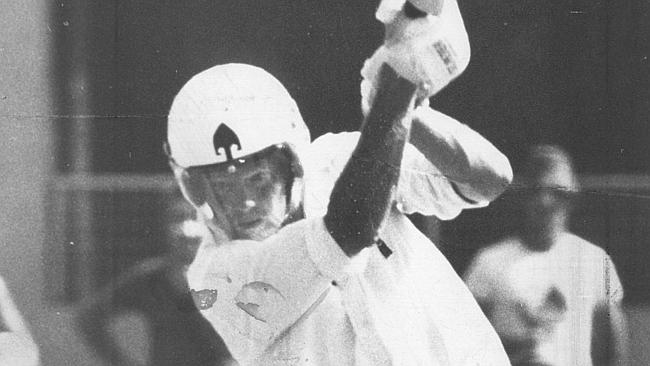27th November 2015
| Donald Elam
ECB announces new safety measures for helmets within professional and recreational cricket

Things have moved along somewhat since Tony Greig's Day!
The ECB Board has endorsed changes to the regulations governing the use of helmets across the professional and recreational game.
From next season, all male and female cricketers playing in professional cricket matches will be required to use helmets which meet the latest British safety standard. The key changes will apply to batsmen facing all types of bowling, wicket-keepers standing up to the wicket and fielders closer than eight yards from the batsman’s middle stump, except behind the wicket on the off side.
ECB is also recommending that all recreational cricketers wear helmets which meet the latest British safety standard from next season. The use of protective headgear is already mandatory for all Under 18s within the recreational game. Full details and amended regulations will be published in the New Year.
The changes follow a joint review by the ECB and the Professional Cricketers’ Association (PCA) of existing safety guidance and are designed to reduce the risk of head and facial injuries within the game. Key measures which ECB has recently taken in this area include:
- Forming an ECB Cricket Safety Working Group which reviews risks to safety and the well-being of players and spectators.
- Re-defining the role of the ECB Chief Medical Officer to enable greater emphasis to be placed on injury surveillance and research into the safety of the game.Setting up an Emergency Care Working Group to improve training and provision of emergency care standards at FCCC, Second XI and training venues.
- Introducing new concussion guidelines via the ECB’s Sports Science and Medicine department. The department is also working with Birmingham University to conduct further research into concussion in cricket.
- Collaborating with the Loughborough Institute of Sport Technology, through sponsorship of a PHD researching helmet design, head injuries and safety in relation to cricket.
ECB Chief Medical Officer Dr Nick Peirce said: “We can see from our injury surveillance that cricket is not a dangerous sport in comparison to many other leisure activities. However, as we have seen in recent times, the cricket ball can cause significant injury and it is extremely important that players take the appropriate precautions when batting, keeping wicket or fielding close to the stumps.
“The latest cricket helmets have made significant strides in providing protection against potentially catastrophic injury and we would strongly advise all players to make sure their helmet conforms to the latest British Safety Standard. Today’s decision is a major step forward and will help make First Class cricket safer as well as sending a strong message to the recreational game about the importance of helmet safety.”
PCA Chief Executive Angus Porter said: “We welcome today’s decision on helmet use which is the product of a joint initiative between the PCA and ECB. It provides an excellent opportunity for professional cricketers to lead by example and drive greater awareness of the importance of player safety across the whole game.”
What do today’s changes mean for professional cricket? The new regulations apply to all forms of professional match cricket and will require players to use a head protector which meets the latest British safety standard. Any player who does not wear compliant protective headgear will not be permitted to play. This includes matches for all England teams and programmes, county first, second and academy XIs and Women’s Super League and County Championship teams.
Helmet regulations for England’s disability cricketers will be reviewed shortly.
Who will be affected by these changes? The changes, which have been introduced following a full-scale consultation and review by the ECB and the PCA, will apply to the following match situations in the professional game:
- Batsmen (for all types of bowling)
- Wicket-keepers while standing up to the wicket
- Fielders closer than 8 yards from the batsman’s middle stump, except behind the wicket on the off side.
What will these changes mean for Under 18s?
Under current rules for Under 18s, batsmen and wicket-keepers standing up to the stumps must wear a head protector. This rule will continue to apply, but it is now strongly recommended that all Under 18s who are in the ECB’s county age-group programmes and above should wear a head protector which meets the relevant latest British Safety Standard when batting, close fielding (except behind the wicket on the off-side) or wicket keeping standing up to the stumps.
What will these changes mean for recreational cricketers?
For adults over the age of 18 in recreational cricket, the wearing of head protectors by batsmen and wicketkeepers continues to be strongly recommended, preferably which meet the relevant latest British Safety Standard.
Where can I find the British Safety Standard approved helmet?
As of November 2015, there are more than 20 helmets from seven different manufacturers that meet the new standard. The full list of helmets meeting this standard (BS7928:2013), is available at www.ecb.co.uk/helmets.
Do recreational cricketers need to buy a new helmet as a result of these changes?
No. It will not be mandatory for recreational players to buy a new helmet, but we strongly advise they check the safety standard before making any new purchases. Helmets should in any event be replaced after they have received a significant impact.
Full details and amended regulations will be published in the New Year. ends For further information contact: Andrew Walpole, ECB Head of Corporate CommunicationsEmail: [email protected] Tel: +44(0)20 7432 1252 : Mobile: +44(0)7785 527102